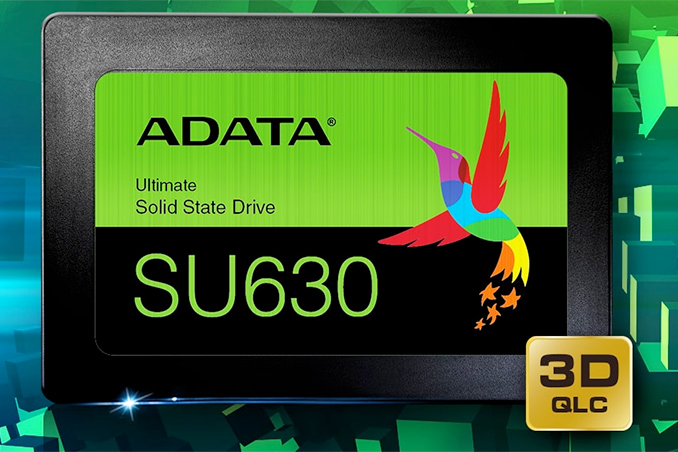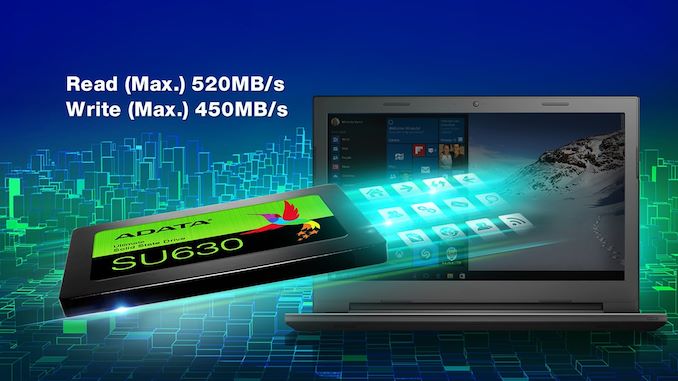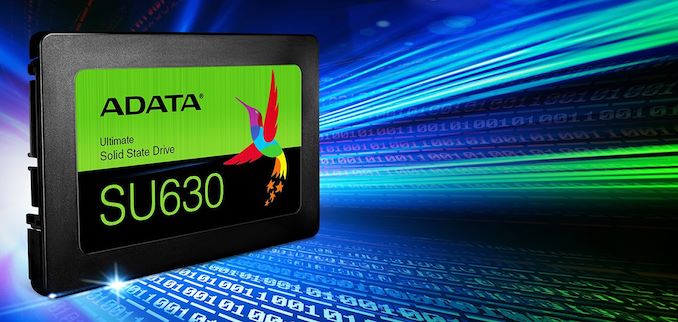ADATA Reveals Ultimate SU630 SSD: 3D QLC for SATA
by Anton Shilov on November 15, 2018 6:30 PM EST
ADATA has introduced its new entry-level SSD for client PCs. The Ultimate SU630 is the first drive from an independent maker of SSDs based on 3D QLC NAND, which is an indicator that the new type of flash memory is finally to the point in terms of production and reliability that companies like ADATA can offer it to their customers, albeit with only a two-year warranty. Notably, the drive is also among the first SATA-based QLC SSDs.
Aimed at entry-level PCs, ADATA’s Ultimate SU630 drives come in a 2.5-inch form-factor and feature 240 GB, 480 GB, and 960 GB configurations. The company says that the Ultimate SU630 SSDs support sequential read performance up to 520 MB/s as well as sequential write performance up to 450 MB/s when pseudo-SLC caching is enabled, based on numbers obtained using the ATTO benchmark. Interestingly, the 240 GB version is not slower than higher-capacity models. As for random performance numbers, the Ultimate SU630 is capable of up to 40,000 read and up to 65,000 write IOPS in case of the 480 GB and 960 GB SKUs.
Moving on to the endurance of the ADATA Ultimate SU630 drives, the 240 GB version is rated for 50 TBW (TB Written), whereas the higher-capacity 480 GB and 960 GB models are rated for 100 and 200 TBW, respectively. To put this in perspective, these endurance ratings are one-third those of ADATA's entry-level 3D TLC NAND-based drives. This is not exactly surprising considering the peculiarities of QLC NAND memory in general. In fact, Crucial P1 SSDs are rated even lower, though the company a five-year warranty on its QLC drives. Meanwhile, ADATA ships its QLC-based drives with just a two-year warranty, which happens to be the minimum allowable warranty in Europe.
| ADATA Ultimate SU630 Specifications | |||
| Capacity | 240 GB | 480 GB | 960 GB |
| Model Number | ASU630SS-240GQ-R | ASU630SS-480GQ-R | ASU630SS-960GQ-R |
| Controller | Maxio Technology MAS0902A-B2C | ||
| NAND Flash | 64-layer 3D QLC NAND | ||
| Form-Factor, Interface | 2.5-inch/7-mm, SATA 6 Gbps | ||
| Sequential Read | 520 MB/s | ||
| Sequential Write | 450 MB/s | ||
| Random Read IOPS | 30K | 40K | |
| Random Write IOPS | 65K | ||
| Pseudo-SLC Caching | Supported | ||
| DRAM Buffer | No | ||
| AES Encryption | unknown | ||
| Power Management | unknown | ||
| Warranty | 2 years | ||
| MTBF | 1,500,000 hours | ||
| TBW | 50 TB | 100 TB | 200 TB |
| DWPD | 0.28 | 0.28 | 0.28 |
| MSRP | $49.99 | $79.99 | $139.99 |
ADATA does not disclose the controller it uses for the Ultimate SU630 SSDs, nor the supplier of 3D QLC memory being used. Keeping in mind how close the company works with Micron and Intel, it is more than likely ADATA is buying their QLC NAND made by one of these companies. As for the controller, so far we have only seen two SATA SSD controllers that are officially capable of handling QLC: Maxio Technology’s MAS0902A-B2C and Phison’s PS3111-S11T. Since Phison usually delivers turn-key SSD solutions with its controllers (i.e., fully assembled drives), ADATA has not been working with this company, which leaves Maxio as the most likely provider of QLC-supporting SATA SSD controller for ADATA.
UPDATE 11/23: ADATA has confirmed Intel's QLC NAND and Maxio Technology's MAS0902A controller.
Overall this is exactly the kind of drive we've come to expect from ADATA. The company has shown that it's not afraid of experimenting with new SSD controllers and NAND memory, and as a result they have dozens of products aimed at a variety of market segments, including niche ones. ADATA was the first independent maker of SSDs to offer drives based on 3D NAND several years ago. With its Ultimate SU630 the company comes up with multiple firsts: it is the first 3D QLC-based SSD from a well-known independent manufacturer, it is the first 3D QLC-based drive with a SATA interface, it is the first QLC SSD (likely) powered by Maxio’s MAS0902A controller from a popular brand. Meanwhile, ADATA makes no secret that the Ultimate SU630 is positioned as its cheapest SATA SSD: the drive formally sits below the Ultimate SU650/SU655, SU700, SU800, SU900, and XPG SX950U products, some of which are three years old.
Time to talk about pricing of the Ultimate SU630. ADATA plans to sell the 240 GB model for $49.99, the 480 GB model for $79.99, and the 960 GB version for $139.99. Keeping in mind that street prices are usually below MSRPs, recommended prices of the new drives look competitive against other cheap SSDs. In the meantime, when acquiring such products one should keep in mind that their endurance is below that of many other inexpensive drives available today.
Related Reading:
- The Crucial P1 1TB SSD Review: The Other Consumer QLC SSD
- Phison: PS5012-E12 Controller in Mass Production, 20+ SSDs Incoming
- The Intel SSD 660p SSD Review: QLC NAND Arrives For Consumer SSDs
- Samsung Discloses First Details About QLC-Based Client & Server SSDs
- We Found a Prototype 4 TB Intel QLC SSD
Source: ADATA












14 Comments
View All Comments
taisingera - Thursday, November 15, 2018 - link
The prices seem high for QLC flash when an Adata 250GB SU800 can be had for $53 using TLC. QLC is just too unknown of a quantity for reliability. For the low TBW of the QLC flash, maybe in the future these would be good for secondary drives with a bunch of media files that you only need to read from.Glock24 - Thursday, November 15, 2018 - link
I just bought a 500GB 860 Evo for $75. I don't see the bargain for these QLC drives. The same goes for DRAMless drives, the price is not low enough to justify the lower performance and lower endurance.CheapSushi - Tuesday, November 20, 2018 - link
Yeah anyone thinking QLC is for a main drive is thinking about it all wrong. QLC is meant to take over bulk storage. You go for Optane or MLC/TLC for a main drive and QLC for your bulk storage unless you literally can't put in more than one drive into the entire system ever.Lolimaster - Friday, November 16, 2018 - link
QLC IS ABSOLUTELY WORTHLESS if they don't focus on delivering 4TB+ SSD for consumer storage for less than $700.For any other storage TLC is already as cheap and if you want to go deeper into the sink, dramless TLC.
WHAT'S THE POINT
Top of the line for consumer oriented MX500/860EVO 1TB are already at $165.
The_Assimilator - Friday, November 16, 2018 - link
Amen!Amandtec - Friday, November 16, 2018 - link
The yields are low at the start so they sell what they produce at a price like then. Over the months the yields will improve dramatically and we will see price decreases from 96 layer and QLC filter through. I paid $200 for a 120 GB drive a couple years back. Ergo - MLC and TLC were not useless - and neither will QLC be.Amandtec - Friday, November 16, 2018 - link
"like this."PaoDeTech - Friday, November 16, 2018 - link
If QLC will save people from the life draining performance of a spinning HDD, I am all for it. Whoever complains about lower cost SSD tech, I am sure, already own an SSD. That said, the minimum size for a QLC SSD should be 500GB.dromoxen - Friday, November 16, 2018 - link
youu'll take my spinners from my cold dead hands, (or when 5bit SSD match the price per GB) just lost a 3tb by dropping it, so ssd has value beyond speed. These are dramless tooLolimaster - Friday, November 16, 2018 - link
Using QLC for less capacity storage is just wrong.One thing I know is that my next main system drive will be optane (2019 intel version, 200GB~), currently im running fine on a BX300 120GB MLC :D